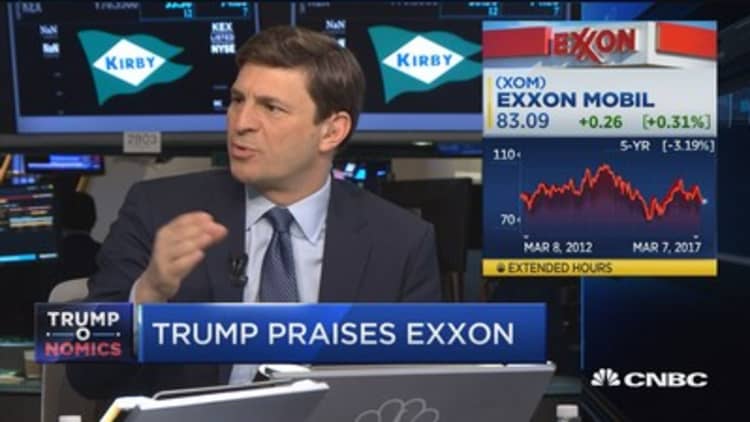The United States is in the early stages of a manufacturing renaissance, and is expected to grow, thanks to cheap and plentiful natural gas.
The U.S. is expected to see a wave of petrochemical plant openings between now and next year. Those plants represent about $50 billion of $160 billion in manufacturing investment earmarked by the industry since 2012, according to James Fitterling, president and COO of Dow Chemical. Among them are several big ethylene plants, including one expected to be opened by Dow in Freeport, Texas, in the second quarter.
"It's about 1.5 million tons of new capacity for us. It will be up in the second quarter sometime," said Fitterling, speaking in Houston at the CERAWeek conference, sponsored by IHS Markit. He said Dow also opened a billion-dollar propane dehydrogenation plant in Freeport at the end of 2015. "That was the first megaproject we've done on the Gulf Coast for quite some time."
Exxon Mobil this week announced a $20 billion spending program to expand its manufacturing capacity along the Gulf Coast, including some previously announced investment. The announcement came at CERAWeek.
Industry executives say this is the first big wave of chemical plant construction in decades.
President Donald J. Trump tweeted congratulations on Exxon's investment and promise of jobs. But the petrochemical renaissance has been building for several years. Trump's policy may unleash more if it results in the creation of pipelines and other infrastructure.
"The U.S. has gone from a shale gas boom to a petrochemical boom," said Scott Sheffield, CEO of Pioneer Natural Resources. While natural gas industry experts discussed the outlook for a long period of low gas prices at the conference, the petrochemical industry described what only can be viewed as a boom in an industry that had been declining in the United States.
Fitterling said there was a wave of plants that started construction back in the 2012 time frame, and between 2017 and 2018, there will be approximately $50 billion of that total $160 billion of capacity up and running. "These are all downstream petrochemical plants, including ethylene facilities, propylene facilities and all the downstream products associated with them. Another wave of plants — some that started and some that were a little bit delayed and slid out to the 2019 time frame — represent another $12 billion," Fitterling said. There are more than 20 big projects and other smaller ones, all which should be completed by 2023.
Another wave of new capacity is likely to be planned after that, Fitterling said. There are estimates that the current planned investment could generate 70,000 to 80,000 direct jobs.
"Between 2000 and 2010 we were actually shutting down U.S. petrochemical plants, but shale has allowed the U.S. industry to come back," said Dave Witte, IHS Markit senior vice president of oil markets, midstream, downstream and chemicals. Witte said not only is the petrochemical industry attracted to the United States but it's likely related businesses in plastics could begin to open facilities in the United States.

Natural gas production in the United States is expected to continue to grow, with an expanding LNG export market that should make the United States a net exporter in the next several years, along with pipeline gas sales to Mexico.
Natural gas analysts say industrial demand is one thing that could help the natural gas market, which is expected to see prices remain flat for years. That's a positive for the petrochemical industry, which uses natural gas as a feed stock. There are five big ethylene plants coming online on the Gulf Coast in coming months, and the first, Occidental Petroleum's joint venture with Mexichem, started up this past week. Others are being built by Exxon Mobil and a Chevron Phillips venture.
The big ethylene plants are energy intensive, and now it's cheaper to operate them in the United States, where plentiful natural gas is less expensive than other locations. "They're so big, they consume 75,000 (barrels of oil equivalent) a day," Witte said. He expects to see more big plants come online, and in places like Ohio and Pennsylvania. Royal Dutch Shell currently has a big project under way in Pennsylvania.
Dow's next big-scale project would be in a seven- to 10-year window. "The question is, where would that be? We have a range of options around the world where that might be," Fitterling said. "If the environment is right and the economy's right here, and you'd think with the reserves you've got in the U.S., the U.S. is going to be on that shortlist as a place to make a next-generation investment," he said.





